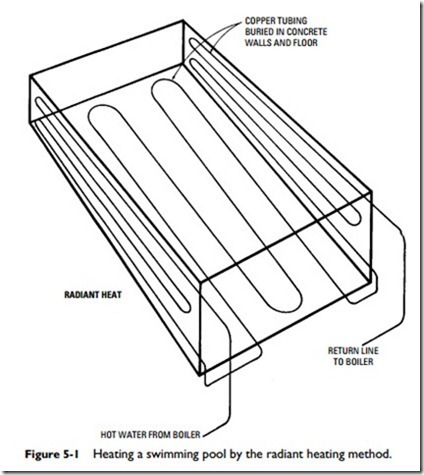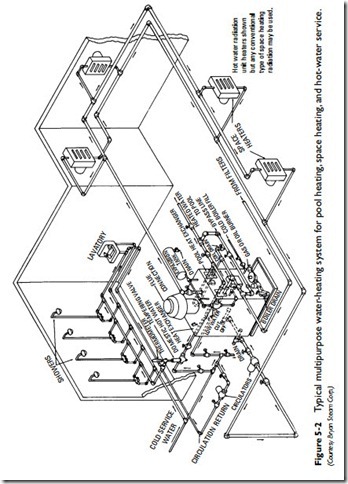Heating systems have been added to both private and commercial swimming pools for a variety of reasons, ranging from the simple desire to increase body comfort with warmer water temperatures to the more practical reason of extending the swimming season.
In many commercial buildings and larger residences equipped with hot-water (hydronic) heating systems, the central boiler pro- vides the heat for space heating, domestic hot water, and pool water. In structures equipped with other heating systems (for exam- ple, forced warm-air), a pool heater operating independently of the central heating unit is necessary to heat the pool water. The water in a swimming pool may be heated in one of the three following ways:
1. Solar heating
2. Radiant heating
3. Recycling
Solar heating relies on the use of solar panels to collect the heat from the sun. The pool water is circulated through the panels where it collects the heat from the sun and then carries it back down to the pool. Many solar pool-heating systems have an auxiliary gas or electric heater to augment the heat from the panels on days where there is insufficient sunlight.
Pools can also be heated with a radiant heating system, but such a system must be installed when the pool is constructed because it entails embedding tubing (commonly 1⁄2-inch diameter) in the pool itself. As shown in Figure 5-1, the tubing is buried close to the sur- face in the walls and floor of the pool. The hot water is fed through a supply pipe from the boiler. The water returns to the boiler through a return line. Water temperature in the pipes is controlled by a thermostat, which usually is located on the return line.
Radiant heating systems for swimming pools are the most expensive types to install because they require more pipe than other heating systems. Furthermore, the construction feature of having the copper tubing embedded in the walls and floor of the pool adds to the installation cost.
Most modern pool heating systems are based on the recycling principle. The water is drawn from the pool by a pump, passed to the heat exchanger in the boiler or pool heater, heated to the desired temperature, and returned to the swimming pool.
When both a pool and its heating system are installed during the original construction of the house or building, it is possible (and advisable) to install a single boiler with more than one heat exchanger. As a result, the boiler will have the capacity to provide
hot water not only for the pool but also for space heating and domestic hot-water needs. Three such systems for commercial buildings are illustrated in Figures 5-2, 5-3, and 5-4. In these sys- tems, the primary boiler water is maintained at the desired space- heating water temperature by the operating aquastat in the boiler. The temperature of the pool water is maintained by the opening and closing of a pool temperature-control valve located in the cir- culation line between the filter and heater. This valve is controlled by a pool temperature-control aquastat, which senses the tempera- ture of the water being returned from the pool.
Pool heaters can also be installed independent of space heating and domestic hot-water heating systems. This is usually the case when a heating unit is installed at an existing pool.
A pool heater operates on the same principle as the domestic hot-water heater, but the two differ considerably in their functions. The hot-water heater is required to heat only 30 to 40 gallons of water in a closed tank. The pool heater must heat thousands of gal- lons of water with a surface exposed to the outside air. Because there is a high degree of heat loss from the large surface area of the water to the colder air above it, a pool heater uses a considerable amount of fuel to replace the lost heat and to maintain the pool water at the desired temperature. The fact that water has a high heat capacity contributes to the problem. As a result, it generally takes a pool heater 20 to 24 hours to warm the water to the desired temperature.
Classifying Pool Heaters
Pool heaters can be classified in a number of different ways. If they are classified according to their basic operating principle, the fol- lowing two types are recognized:
1. Direct-type pool heaters
2. Indirect-type pool heaters
In a direct-type pool heater (see Figure 5-5), the water from the pool passes through the heating unit in pipes that are heated directly by a gas or oil burner. In an indirect-type pool heater (see Figure 5-6), the pipes containing the pool water pass through a compartment in the heating unit, which also contains water. The water in the compartment of the heating unit is heated by a gas or oil burner located outside the water compartment. The heat of the water is then transferred to the water in the pipes from the pool,
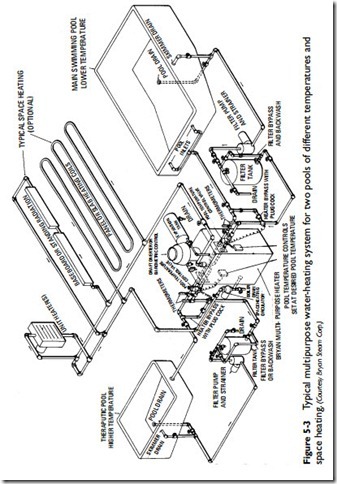
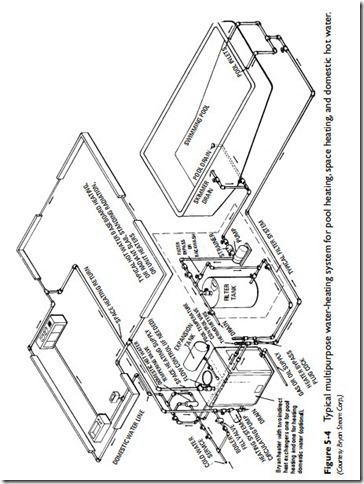
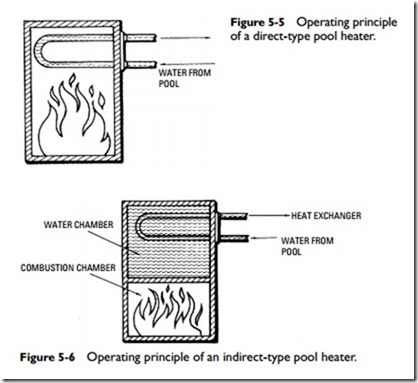 hence the name indirect pool heater. Because the coils of the heat exchanger never come in direct contact with the combustion heat (as is the case with direct-type pool heaters), scale and corrosion are virtually eliminated.
hence the name indirect pool heater. Because the coils of the heat exchanger never come in direct contact with the combustion heat (as is the case with direct-type pool heaters), scale and corrosion are virtually eliminated.
Another means of classifying pool heaters is by the type of fuel or nergy source used to heat the water. The pool water can be heated by natural gas or propane, oil, electricity, or solar radiation.
Note
When installing a conventional pool heating system, purchase a heater with a high efficiency rating. It will save energy and result in significantly lower fuel costs.
